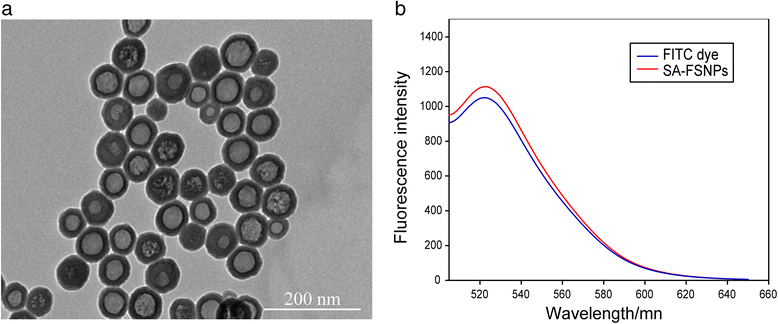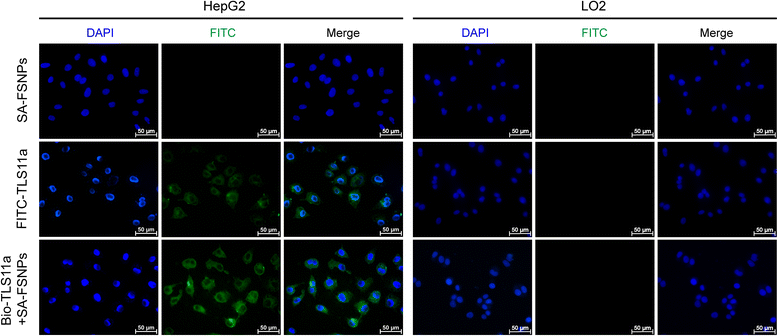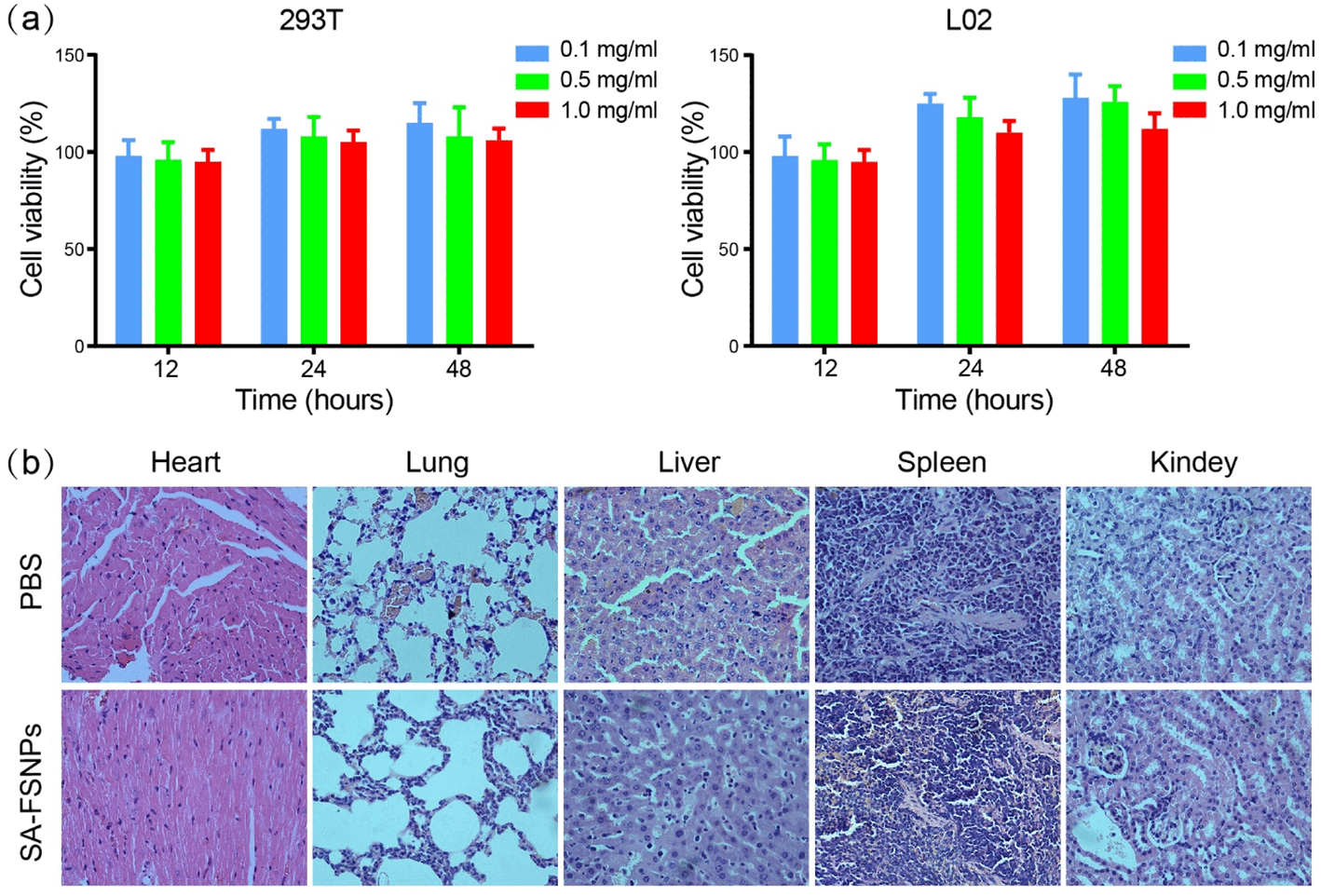Aptamer Combined with Fluorescent Silica Nanoparticles for Detection of Hepatoma Cells
- PMID: 28176286
- PMCID: PMC5296265
- DOI: 10.1186/s11671-017-1890-6
Aptamer Combined with Fluorescent Silica Nanoparticles for Detection of Hepatoma Cells
Erratum in
-
Correction to: Aptamer combined with fluorescent silica nanoparticles for detection of hepatoma cells.Discov Nano. 2025 Aug 25;20(1):146. doi: 10.1186/s11671-025-04306-7. Discov Nano. 2025. PMID: 40853420 Free PMC article. No abstract available.
Abstract
Purpose: The purpose of this study is to develop a simple, effective method to label hepatoma cells with aptamers and then detect them using fluorescent silica nanoparticles (FSNPs).
Method: Streptavidin was conjugated to carboxyl-modified fluorescein isothiocyanate (FITC)-doped silica nanoparticles which were prepared by the reverse microemulsion method. The resulting streptavidin-conjugated fluorescent silica nanoparticles (SA-FSNPs) were mixed with hepatoma cells that had been labeled with biotin-conjugated aptamer TLS11a (Bio-TLS11a). The specificity and sensitivity of the nanoprobes were assessed using flow cytometry and fluorescence microscopy. Their toxicity was assessed in normal human liver cell cultures using the MTT assay, as well as in nude mice using immunohistochemistry.
Results: SA-FSNPs showed uniform size and shape, and fluorescence properties of them was similar to the free FITC dye. SA-FSNPs were able to detect aptamer-labeled hepatoma cells with excellent specificity and good sensitivity, and they emitted strong, photobleach-resistant fluorescent signal. SA-FSNPs showed no significant toxic effects in vitro or in vivo.
Conclusion: The combination of biotin-conjugated aptamers and SA-FSNPs shows promise for sensitive detection of hepatoma cells, and potentially of other tumor cell types as well.
Keywords: Aptamer; Cancer; Fluorescent nanoparticles; Hepatoma.
Conflict of interest statement
The authors declare that they have no competing interests.
Figures






Similar articles
-
Prescription of Controlled Substances: Benefits and Risks.2025 Jul 6. In: StatPearls [Internet]. Treasure Island (FL): StatPearls Publishing; 2025 Jan–. 2025 Jul 6. In: StatPearls [Internet]. Treasure Island (FL): StatPearls Publishing; 2025 Jan–. PMID: 30726003 Free Books & Documents.
-
Signs and symptoms to determine if a patient presenting in primary care or hospital outpatient settings has COVID-19.Cochrane Database Syst Rev. 2022 May 20;5(5):CD013665. doi: 10.1002/14651858.CD013665.pub3. Cochrane Database Syst Rev. 2022. PMID: 35593186 Free PMC article.
-
A novel theranostic system of PD-L1-Aptamer-functionalized fluorescent silica nanoparticles for triple-negative breast cancer.Nanomedicine. 2025 Aug;68:102834. doi: 10.1016/j.nano.2025.102834. Epub 2025 Jun 13. Nanomedicine. 2025. PMID: 40516668
-
Toxicity of fluorescent silica nanoparticles in brine shrimp and their implications as food ingestion markers.Sci Rep. 2025 Jul 17;15(1):25897. doi: 10.1038/s41598-025-11858-2. Sci Rep. 2025. PMID: 40670610 Free PMC article.
-
The effect of sample site and collection procedure on identification of SARS-CoV-2 infection.Cochrane Database Syst Rev. 2024 Dec 16;12(12):CD014780. doi: 10.1002/14651858.CD014780. Cochrane Database Syst Rev. 2024. PMID: 39679851 Free PMC article.
Cited by
-
Aptamers as Diagnostic Tools in Cancer.Pharmaceuticals (Basel). 2018 Sep 11;11(3):86. doi: 10.3390/ph11030086. Pharmaceuticals (Basel). 2018. PMID: 30208607 Free PMC article. Review.
-
Recent Advances in Nanomaterial-Based Aptasensors in Medical Diagnosis and Therapy.Nanomaterials (Basel). 2021 Apr 6;11(4):932. doi: 10.3390/nano11040932. Nanomaterials (Basel). 2021. PMID: 33917467 Free PMC article. Review.
-
Target-responsive ratiometric fluorescent aptasensor for OTA based on energy transfer between [Ru(bpy)3]2+ and silica quantum dots.Mikrochim Acta. 2020 Apr 14;187(5):270. doi: 10.1007/s00604-020-04245-3. Mikrochim Acta. 2020. PMID: 32291531
-
Correction to: Aptamer combined with fluorescent silica nanoparticles for detection of hepatoma cells.Discov Nano. 2025 Aug 25;20(1):146. doi: 10.1186/s11671-025-04306-7. Discov Nano. 2025. PMID: 40853420 Free PMC article. No abstract available.
-
Water-dispersed silicon quantum dots for on-off-on fluorometric determination of chromium(VI) and ascorbic acid.Mikrochim Acta. 2019 Sep 7;186(10):673. doi: 10.1007/s00604-019-3751-8. Mikrochim Acta. 2019. PMID: 31494775
References
-
- Etzioni R, Urban N, Ramsey S, McIntosh M, Schwartz S, Reid B, Radich J, Anderson G, Hartwell L (2003) The case for early detection. Nat Rev Cancer 3:243–2452 - PubMed
-
- Valente K, Yacoub G, Cappellari JO, Parks G (2016) Metastatic pancreatic acinar cell carcinoma in a younger male with marked AFP production: A potential pitfall on fine needle aspiration biopsy. Diagn Cytopathol doi. doi:10.1002/dc.23610 - PubMed
-
- Sabour L, Sabour M, Ghorbian S (2016) Clinical applications of next-generation sequencing in cancer diagnosis. Pathol Oncol Res doi. doi:10.1007/s12253-016-0124-z - PubMed
-
- Ganji A, Varasteh A, Sankian M (2016) Aptamer: new arrows to target dendritic cells. J Drug Target 24:1–12 - PubMed
-
- Groff K, Brown J, Clippinger AJ (2015) Modern affinity reagents: recombinant antibodies and aptamers. Biotechnol Adv 33:1787–1798 - PubMed
LinkOut - more resources
Full Text Sources
Other Literature Sources

